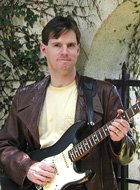I've recently bought Chord Tone Soloing and for the first time in a long time am excited to get stuck in to some proper learning, it's brilliantly written so thank you for that. I have a quick question if that's ok: At the start of section II you set out the octave shapes and the corresponding major scape shapes. Now I've stumbled across CAGED references before but never done anything with it, but what I do notice is that most other places refer to your 'shape 1' as 'shape 3' - obviously it's only a small terminology discrepancy, but I wondered what the thinking behind it was? I'm happy to stick with the nomenclature in your book and make mental note to translate when I read about CAGED shapes elsewhere but just thought I'd ask.
Anyway thanks again for what looks to be a great learning resource,
Tim
Hi Tim,
If you go through the book and identify and mark some of the diagrams with your previous numbering system, soon you'll be familiar with both ways and can decide if you'd like to adopt the new way.
The system you learned before probably started its numbering on the basis of which chord shape is easiest to play or most likely to be used by a beginner. An E-shaped barre chord is used as pattern 1 in those systems. (That makes the D shape into pattern 2, and the C shape into pattern 3, etc.)
The CAGED system and the 5 patterns derived from it that are used in all Musicians Institute programs (including my books) start with the C shape as pattern 1. The logic here is based on music theory instead of physical reasons. For example, the key of C is the first you should learn to read music in as it has no sharps or flats. You'll also begin with the C major scale to study how chords and intervals are built.
Here is one octave's worth of the pattern 1 major scale tabbed out in open position. Key of C major. (An octave is the eight-note distance up the scale to another note with the same letter name.) In tablature, the top line is the string closest to the floor.
-----------------
------------0-1--
--------0-2------
--0-2-3----------
3----------------
-----------------
C D E F G A B C
1 2 3 4 5 6 7 8
The C major "campfire chord" in open position is then also called pattern 1, and the shapes move up the neck from there. You don't have to finger and play these chords in their entirety. To get the sound of the chord in any position you only need to play the root, 3rd and 5th: one instance each of the C, E, and G notes. Try playing these examples one note at a time instead of trying to finger the entire shape right off. The eventual goal is just to know where the chord factors (Root, 3rd, 5th) are in relation to each other in each shape.
From left to right in each, we have the fretted string (starting with the string closest to the floor), the note name, and the scale degree, which is also the chord factor.
Pattern 1 (C shape)
0 E 3rd
1 C Root
0 G 5th
2 E 3rd
3 C Root
0 E 3rd
Pattern 2 (A shape)
3 G
5 E
5 C
5 G
3 C
3 G
Pattern 3 (G shape)
8 C
5 E
5 C
5 G
7 E
8 C
Pattern 4 (E shape)
8 C
8 G
9 E
10 C
10 G
8 C
Pattern 5 (D shape)
12 E
13 C
12 G
10 C
10 G
12 E
Thanks for getting my book, and thanks very much for the compliments.
For everyone else, the book we are discussing is here:
Chord Tone Soloing.
Thanks again, and I hope you're having fun!
Barrett


No comments:
Post a Comment